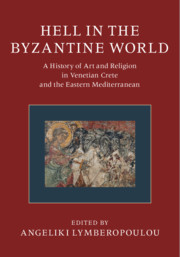 Hell in the Byzantine World
Hell in the Byzantine World from Part II - Eastern Mediterranean
Published online by Cambridge University Press: 02 October 2021
Annemarie Weyl Carr examines the shifting imagery of post-mortem punishment in twenty-two depictions of the Last Judgment on Cyprus. The earliest versions, dating from the 12th through mid-14th century, cover three-dimensional, vaulted interiors. Centred on Christ, with degrees of punition arranged around him to contrast with either one another or beatitude, they present punishment as a range of conditions, not a place. The next group, dating from the mid-14th through the 15th century, are organised bilaterally around the scale of judgment, thus creating a clear differentiation between redemption and condemnation. Condemnation, however, remains chaotic, a state of being cast out, not a destination to which one goes. The final images, dating from the late 15th and16th centuries, occupy a single surface each. The Last Judgment may hover as a prophetic future, engulf as a wrap-around panorama, or spread in a landscape, but in each case, the events of punishment are in some way accorded a defined place. Thus, the Cypriot churches show a growing tendency to attribute spatial qualities to Hell. This space, however, embracing the whole of morality from sin and death through resurrection and judgement to damnation, has little in common with the Hell of western European art.
To save this book to your Kindle, first ensure no-reply@cambridge.org is added to your Approved Personal Document E-mail List under your Personal Document Settings on the Manage Your Content and Devices page of your Amazon account. Then enter the ‘name’ part of your Kindle email address below. Find out more about saving to your Kindle.
Note you can select to save to either the @free.kindle.com or @kindle.com variations. ‘@free.kindle.com’ emails are free but can only be saved to your device when it is connected to wi-fi. ‘@kindle.com’ emails can be delivered even when you are not connected to wi-fi, but note that service fees apply.
Find out more about the Kindle Personal Document Service.
To save content items to your account, please confirm that you agree to abide by our usage policies. If this is the first time you use this feature, you will be asked to authorise Cambridge Core to connect with your account. Find out more about saving content to Dropbox.
To save content items to your account, please confirm that you agree to abide by our usage policies. If this is the first time you use this feature, you will be asked to authorise Cambridge Core to connect with your account. Find out more about saving content to Google Drive.